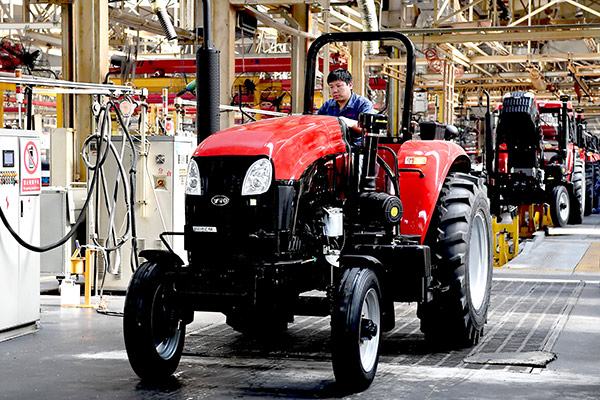
A tractor comes off the production line of YTO Group Corp in Luoyang, Henan province.[Photo/Xinhua]
Mixed-ownership reform of a number of central State-owned enterprises is expected to be approved within the third quarter of this year, as the coal, steel, heavy equipment and thermal power sectors will become the government’s priority in restructuring its giant SOEs, said experts on July 4.
Mixed-ownership reform acts as a major part of the overall reform of SOEs. It is pushed by factors including China’s ongoing supply-side reform, the Belt and Road Initiative and many Chinese companies’ “going global” strategy, as well as the “Made in China 2025” plan.
A group of central SOEs, including China National Aviation Holding Co, Power Construction Corp of China and China National Cereals, Oils and Foodstuffs Corp, have already started to draft plans for mixed-ownership reform.
“Even though it is still in the early stage, central SOEs will face issues including monopoly and the placement of employees during the process of mixed ownership reform. But as these enterprises are all strong and competitive, they have the ability to solve problems such as employee placement,” said Li Jin, chief researcher at the China Enterprise Research Institute.
“As for the monopoly issue, we cannot expect it to be solved in the short term. We can and will promote it gradually.”
A total of 91 central SOEs achieved a rise in revenue during the first quarter of this year, with 54 of them, including defense-related industries, construction materials, pharmaceuticals and modern services, witnessing a rise of 10 percent or more, and sectors such as oil, steel and coal experiencing an increase in revenue of at least 40 percent.
“It is imperative that the coal industry starts to restructure this year. Central SOEs in the coal industry will integrate coal resources at the central level, and then at provincial-level companies,” Li said.
In terms of heavy equipment, China First Heavy Industries Co, Harbin Electric Corp and Dongfang Electric Corp are likely to integrate as the majority of their business is similar.
“Against a backdrop of tackling overcapacity, there’s a growing likelihood that China State Shipbuilding Corp and China Shipbuilding Industry Corp, two major Chinese shipbuilding companies, will merge,” Li said.
He Jingtong, a business professor at Nankai University in Tianjin, said that mergers and consolidation will take place in power companies affiliated to the five big power generation giants — China Datang Corp, Huaneng Power International Inc, Huadian Power International Co, GD Power Development Co and State Power Investment Corp.
The State-owned Assets Supervision and Administration Commission said last week that China Hi-Tech Group Corp has been merged with China National Machinery Industry Corp (Sinomach). Sinomach produces construction and agriculture equipment, while China Hi-Tech is a textile machinery manufacturer.
By now, the number of central SOEs has been cut to 101. SASAC plans to reduce the number of central SOEs to under 100 this year.
